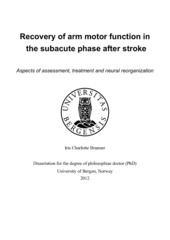| dc.contributor.author | Brunner, Iris Charlotte | en_US |
| dc.date.accessioned | 2013-03-04T12:20:15Z | |
| dc.date.available | 2013-03-04T12:20:15Z | |
| dc.date.issued | 2012-12-17 | eng |
| dc.identifier.isbn | 978-82-308-2180-0 | en_US |
| dc.identifier.uri | https://hdl.handle.net/1956/6376 | |
| dc.description.abstract | Early after stroke, approximately two thirds of all patients experience impaired motor function of an arm impacting personal, social and occupational areas. The objective of this thesis was to examine different aspects of arm motor recovery in the subacute phase after stroke with regard to possible treatment alternatives. This was realized in three different studies: In the first study the recovery of arm motor function and the proportion of patients eligible for Constraint-induced movement therapy (CIMT) were examined in a longitudinal, repeated measurement design. In the second study two different treatment approaches for patients with mild to moderate paresis of an arm were compared in a randomized controlled trial. In the third study functional MRI was applied to study changes in potential mirror neurons after stroke and compared to healthy controls. The first study revealed that the number of patients regarded eligible for CIMT, according to defined motor criteria, constantly decreased during the first 3 months. Most patients with mild to moderate paresis regained satisfactory arm function, all receiving standard rehabilitation. In conclusion, it was proposed that CIMT should not be offered sooner than 4 weeks post stroke to patients with persisting motor deficits. No difference in change between the group receiving modified CIMT and the group receiving bimanual training was found in the second study. The results suggest that bimanual training may be as effective as modified CIMT in improving arm function in the subacute phase after stroke. In the third study changes over time in potential mirror neurons were found, concomitant with improvement of arm motor function. The activation of mirror neurons early and late after stroke and in healthy control subjects strengthens the notion that treatment approaches targeting those neurons may be a means of restoring arm motor function after stroke. | en_US |
| dc.language.iso | eng | eng |
| dc.publisher | The University of Bergen | eng |
| dc.relation.haspart | Paper I: Brunner, I.C., Skouen, J.S. and Strand, L.I. (2011): Recovery of upper extremity motor function with regard to eligibility for constraint-induced movement therapy. Topics in Stroke Rehabilitation 18(3): 248-257, May-June 2011. . Full text not available in BORA due to publisher restrictions. The article is available at: <a href="http://dx.doi.org/10.1310/tsr1803-248" target="blank"> http://dx.doi.org/10.1310/tsr1803-248</a> | en_US |
| dc.relation.haspart | Paper II: Brunner, I. C., Skouen, J. S. and Strand, L. I. (2012): Is modified Constraint-induced movement therapy more effective than Bimanual training in improving arm motor function in the subacute phase post stroke: A randomized controlled trial. Clinical Rehabilitation 26(12): 1078-1086 December, 2012. Full text not available in BORA due to publisher restrictions. The article is available at: <a href="http://dx.doi.org/10.1177/0269215512443138" target="blank"> http://dx.doi.org/10.1177/0269215512443138</a> | en_US |
| dc.relation.haspart | Paper III: Brunner, I. C., Skouen, J. S., Ersland, L. and Grüner, R. Plasticity and response to action observation: A longitudinal fMRI study of potential mirror neurons in patients with subacute stroke. Full text not available in BORA. | en_US |
| dc.title | Recovery of arm motor function in the subacute phase after stroke. Aspects of assessment, treatment and neural reorganization | en_US |
| dc.type | Doctoral thesis | |
| dc.rights.holder | Copyright the author. All rights reserved | |
